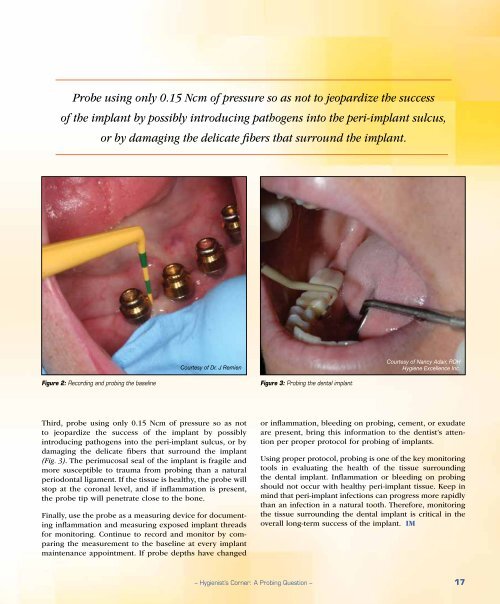PDF Download - Glidewell Dental Labs
PDF Download - Glidewell Dental Labs
PDF Download - Glidewell Dental Labs
You also want an ePaper? Increase the reach of your titles
YUMPU automatically turns print PDFs into web optimized ePapers that Google loves.
Probe using only 0.15 Ncm of pressure so as not to jeopardize the success<br />
of the implant by possibly introducing pathogens into the peri-implant sulcus,<br />
or by damaging the delicate fibers that surround the implant.<br />
Courtesy of Dr. J Remien<br />
Courtesy of Nancy Adair, RDH<br />
Hygiene Excellence Inc.<br />
Figure 2: Recording and probing the baseline<br />
Figure 3: Probing the dental implant<br />
Third, probe using only 0.15 Ncm of pressure so as not<br />
to jeopardize the success of the implant by possibly<br />
introducing pathogens into the peri-implant sulcus, or by<br />
damaging the delicate fibers that surround the implant<br />
(Fig. 3). The perimucosal seal of the implant is fragile and<br />
more susceptible to trauma from probing than a natural<br />
periodontal ligament. If the tissue is healthy, the probe will<br />
stop at the coronal level, and if inflammation is present,<br />
the probe tip will penetrate close to the bone.<br />
Finally, use the probe as a measuring device for documenting<br />
inflammation and measuring exposed implant threads<br />
for monitoring. Continue to record and monitor by comparing<br />
the measurement to the baseline at every implant<br />
maintenance appointment. If probe depths have changed<br />
or inflammation, bleeding on probing, cement, or exudate<br />
are present, bring this information to the dentist’s attention<br />
per proper protocol for probing of implants.<br />
Using proper protocol, probing is one of the key monitoring<br />
tools in evaluating the health of the tissue surrounding<br />
the dental implant. Inflammation or bleeding on probing<br />
should not occur with healthy peri-implant tissue. Keep in<br />
mind that peri-implant infections can progress more rapidly<br />
than an infection in a natural tooth. Therefore, monitoring<br />
the tissue surrounding the dental implant is critical in the<br />
overall long-term success of the implant. IM<br />
– Hygienist’s Corner: A Probing Question – 17

















